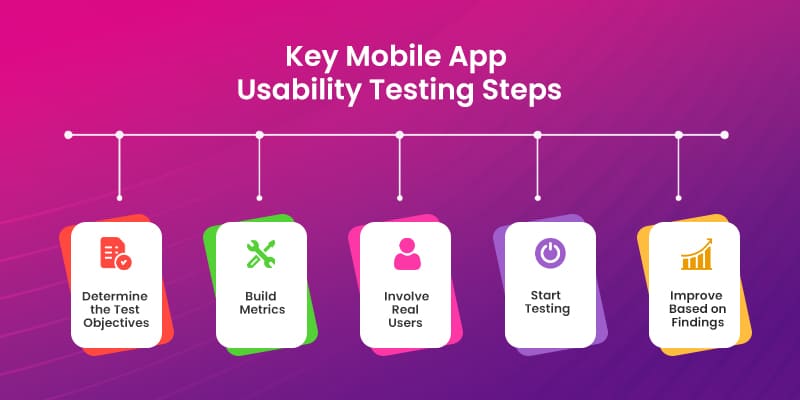
In the field of technology, mobile apps have ushered in a transformation. In terms of telecommunications technology, connectivity, and usefulness, there has been a dramatic shift.
Today, the majority of business operations now take place on mobile devices.
In today’s world, individuals spend 70% of their time on mobile apps. As a result, it’s appropriate to say that developing a custom mobile app for your company is a strategic method to guarantee that people can quickly find you on the web.
Many business owners and entrepreneurs create mobile apps for the benefit, convenience, and delight of their target audience. Also, it expands its reach to the target market. But,
Many entrepreneurs and developers fail to pay attention to mobile app usability testing, which is a very typical problem.
Among the most crucial phases in ensuring a mobile app’s success in the actual situation is to test its usability.
But what exactly is usability testing? Let’s take a look at mobile app usability testing.
So, let’s get started!
What is Mobile Usability Testing?
The method of modeling how a real user might use an app is known as mobile usability testing. It entails evaluating various aspects, including the user interface, functional quality, usefulness, navigational quality, and much more.
These are methods for determining what works and what doesn’t through testing and observing user behavior. You can gather qualitative and quantitative data and identify usability flaws with a product by conducting a usability test.
Mobile app usability testing is used to obtain a greater understanding of how real users interact with and view your mobile phone app and then to enhance the user experience with all those findings. But,
Why is Mobile App Usability Testing so Important?
The penetration of smartphones is increasing: Statista estimates that by 2023, there will be 7.26 billion users worldwide. It’s no surprise that the number of mobile app downloads is expected to reach 258 billion by 2022.
Today, there are applications for every mobile device and function available, and they all rely on user feedback. And you know what?
People will not hesitate to give a negative review if there are issues with performance, user interface, or malfunctioning, so be sure to invest in mobile app usability testing.
The primary goal of doing a mobile usability test is to detect any flaws and ensure that the product provides the value and functionality that users expect. Usability testing ensures that your application adds value to your company while also meeting the expectations of the end-users.
You must do mobile app usability testing at various points throughout your mobile app development process, not just when you’re nearing completion, for the greatest results. If you wait till you’re almost ready to launch your product to the public, you’ll miss out on critical information that could have aided the development process earlier on.
Usability testing should be done when you have a minimal viable product, then again once you have a functioning beta version, and finally when you’re about to launch.
Apart from improving user experiences, there are a number of other reasons why conducting a mobile app usability test is essential:
- By decreasing user annoyance and enhancing consumer happiness, usability software testing guarantees that your solution will be a smash hit.
- Ensures flawless experience to users.
- Early bug and flaw detection reduces the amount of money spent on correcting problems with the released product.
- It helps to identify whether the app fits its purpose or not.
- Mobile Usability testing can assist a developer in improving an app’s UI and adding new functionalities.
- It helps you to know user behavior.
- Mobile app usability testing allows app developers to thoroughly examine the results and make necessary modifications during or after the mobile application development process.
Moving on, let’s move forward and discuss,
Top Benefits of Mobile App Usability Testing!
Below are a few of the advantages of mobile app usability testing. So, take a look!
1. Lowers App Development Cost
The testing process is the primary source of cost savings by reducing the number of issues discovered after deployment. Launching an app with broken features can result in unfavorable customer reviews, app uninstalls, and a negative brand image. So, from the start of development, remember to thoroughly test your app.
2. Improves UI/UX
Quality assurance teams can employ testing to put themselves in the shoes of consumers and evaluate the whole app experience. They investigate the reason underlying the application and double-check that it is simple and easy to understand. If you want to get great results, you’ll need to continuously do UI and UX tests throughout the whole development life cycle.
3. Save Resources
You can use user testing to ensure that your app works properly and those important aspects are immediately accessible. As a result, you may swiftly detect and rectify issues in user journeys early in the initial design instead of spending on a failed completed project.
4. Ensures Competitive Edge
With so many apps on the market, you’ll have to go above and beyond to offer your users an app they’d like to use over another. Investing in an app that satisfies people’s needs may not be enough. Usability testing aids in the development of a solution that is more than just functional and provides a significantly improved user experience.
Moving ahead, let’s talk about,
Top Usability Testing Methods!
Now, consider the following methods for usability testing that you have to include in your test plan:
- Lab Testing – Lab usability testing, as the name implies, is testing conducted in a controlled environment under the supervision of a moderator. A reviewer is a professional who is seeking real-time user comments. When you require in-depth knowledge on how a natural person interacts with your product and what challenges they encounter, lab usability testing is the best option. It will assist you in determining the reasons behind user behavior.
- Guerrilla Testing – The most basic type of usability testing is guerilla testing. Guerrilla testing entails going into a public spot and asking strangers about your prototype. Participants in the test are picked at random. Guerilla testing is most effective in the early stages of mobile app development. When you have a measurable design and want to know if you’re on the right track or not.
- Unmoderated Testing – Unmoderated remote usability testing is conducted without the presence of a moderator. It provides quick, dependable, and low-cost user testing results that can be used for additional analysis. Participants are requested to complete activities in their surroundings, using their own devices, and without the presence of a reviewer, resulting in the natural use of the product.
- Contextual Inquiry – Contextual inquiry is more of a questionnaire method than a usability testing method for helping a product team gather knowledge about the user experience from real people. Contextual inquiry is also useful for determining a user’s level of satisfaction with a product.
- Card Sorting – In a user interface, card sorting is an excellent step in planning content and functions. The method is straightforward: write concepts (content, characteristics) on cards and allow test participants to sort the cards into groups and categories.
Read More:- A Complete Guide on App Development for Start-ups
Moving forward, let’s talk,
Key Mobile App Usability Testing Steps
Below are the most critical steps that you need to take to conduct the best mobile app usability testing. So, take a look!

1. Determine the Test Objectives
Determining the testing objectives is the first step of mobile app usability testing. You will undoubtedly get lost on the path if you are unaware of the objectives. You can concentrate your focus on key things such as:
- Build a detailed plan
- Identifying your target market
- Consolidate app’s specific features and functions that need to be tested
- Examine the most competitive apps
Focusing on these points will ease up your mobile usability testing task. But,
All of this involves professional knowledge and expertise, which you may lack if you don’t have prior tech expertise. As a result, it’s preferable to delegate your app testing tasks to a mobile app development company.
2. Build Metrics
Of course, the purpose of testing is to determine whether your product performs as it should or needs to be improved, so keep in mind your test metrics ahead of time. They also include variables like task completion, time on task, major and non-critical errors, and subjective feedback scores on quality concerns like ease of use and general satisfaction, among other things.
3. Involve Real Users
As usability testing for mobile applications is a user-centered approach, it necessitates the involvement of real users. You won’t be able to generate similar conditions for every user, but you will be able to identify the situations that will help you uncover the app’s flaws. Although your preparations and the process will require time and resources, keep in mind that the more effort and resources you put into this task, the better the outcomes will be.
4. Start Testing
You must eventually perform the test after completing all of the prior activities and laying the groundwork for usability testing. Conduct the testing in a location where you can keep an eye on the testers. You’ll need to provide them with some instructions, such as how to use some of the app’s capabilities or features. Also, give them the testing sheet and ask them to write down their thoughts. It will assist them in sharing all of the details as in a spoken discussion; otherwise, they may forget certain key things.
5. Make Improvements Based on Findings
The last step in the process is to evaluate quantitative data acquired during the testing and make adjustments based on it. This isn’t a simple task that any user or business owner can complete on their own.
So, if you don’t have the necessary experience, don’t take the chance. You can engage the best mobile app development company to conceive, create, and test the app for you, ensuring that it is fully functional and user-friendly for your target demographic.
How can Matellio Help?
Matellio is a prominent usability testing company that offers comprehensive application testing services and solutions for your applications and services. We use the most up-to-date manual and automated tools to obtain the most accurate testing results, which aid in the discovery of bugs, defects, system flaws, or any programming errors in your solution.
Conclusion
Developers aren’t the only ones who can indeed benefit from usability testing. You can test your offerings as a business owner in order to improve their usefulness. To make your mobile application stand apart from the other apps, you have to consider mobile app usability testing.
Usability testing is the opportunity to learn more about your target audience. And the sooner you open the door to the wonderful world of usability, the faster you’ll be able to meet the requirements of your customers and outreach your competition.
The procedure is lengthy, but it is also your rescuer.
Do remember, mobile usability testing can be done in a variety of ways, so it’s important to figure out which one is indeed best for you and your goals.
So, if you want to develop your own custom mobile app? Or are you curious about usability testing and how to improve your app’s user experience? Fill out the contact form to request a free consultation session with one of our professionals.





